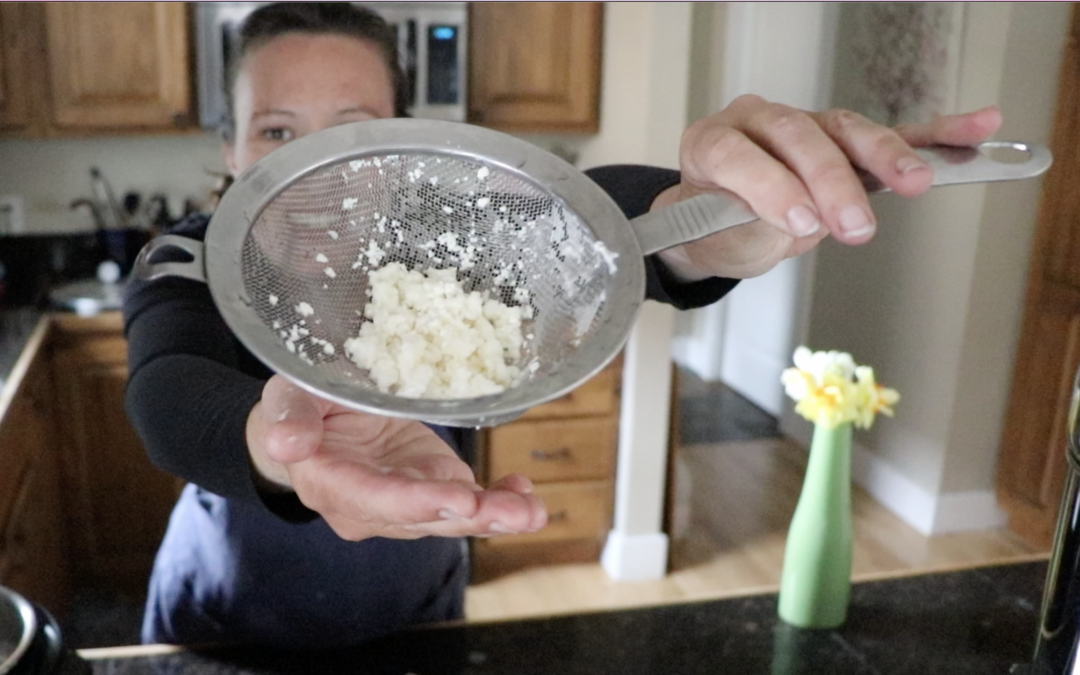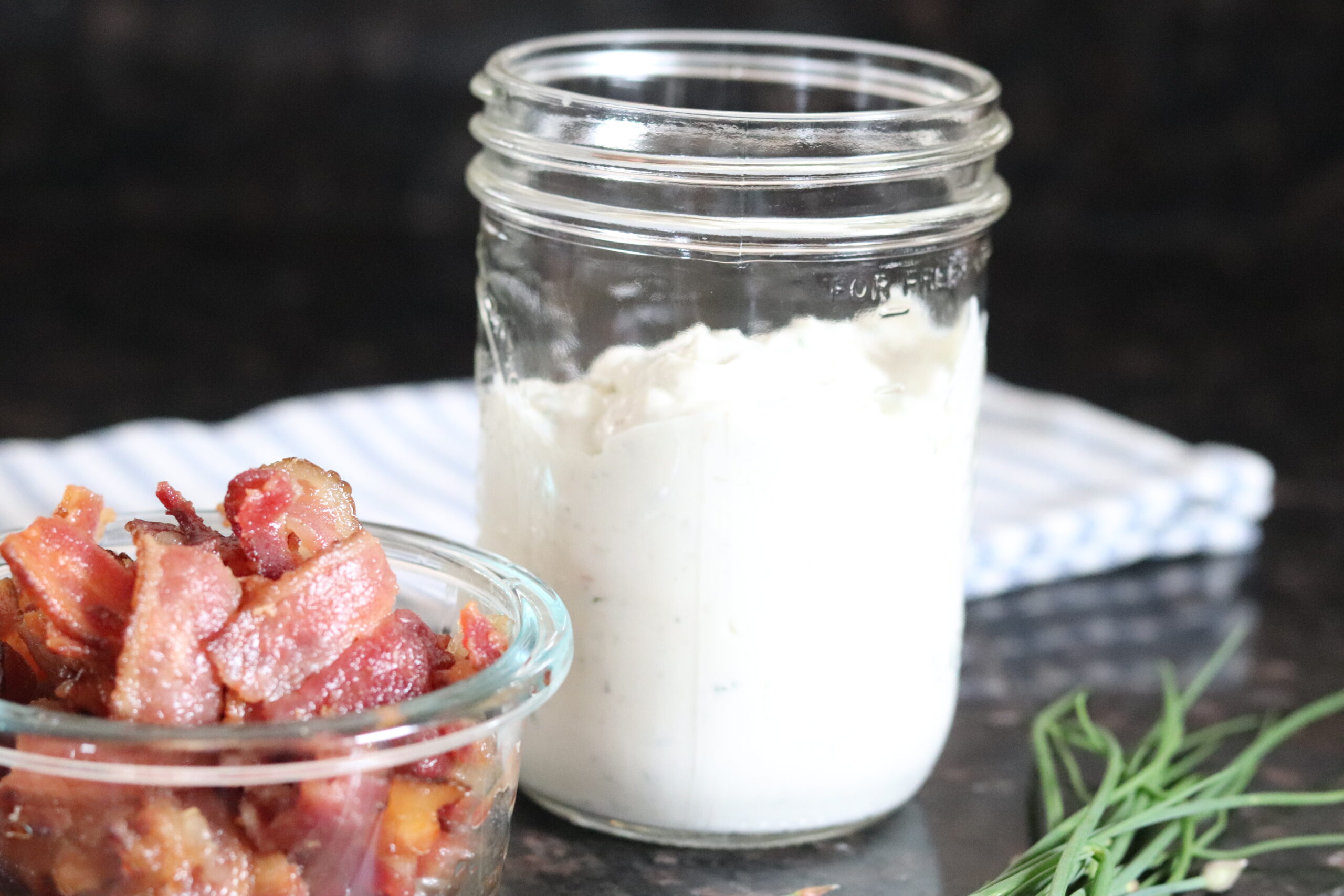Homemade dairy (milk) kefir really is that simple. Plop your kefir grains into a jar, cover with milk or cream, and then 12-24 hours later you have cultured milk that has nearly no lactose left, and is now filled with gut-healing beneficial probiotics.
Over the winter we favor yogurt more, spooning over soup, or mixing chia and dried fruit into it as a fast breakfast. The ability to make a bunch of yogurt cups all at once for rushed school days is our main motivation for choosing yogurt over kefir in the winter.
But for us, summertime is kefir time. An ever present jar on our kitchen counter effortlessly (on our part it is effortless- the culture is working diligently!) produces out this probiotic-rich concoction every 24 hours, just in time for morning smoothies- and popsicles when there is some leftover.
Read: Seasonal Allergies? Try milk kefir to seal your gut and reduce or eliminate allergies!

Dairy Kefir
Ingredients
- 1 tablespoon live kefir grains
- 1/4 cup heavy cream optional
- 2 cups whole milk
Instructions
-
In a quart jar, place your milk kefir grains and cover with milk and cream.
-
Cover to prevent dust or bugs from getting in and allow to sit at room temperature for 12-24 hours. Longer fermenting time will result in more probiotics and a more tart finished product.
-
Using a strainer to catch the grains, pour now finished kefir into another vessel. I like to use my 4-cup measuring cup.
-
Store finished product in fridge or consume immediately.
-
Repeat the process by adding strained kefir grains back into your culturing jar and covering with milk again.
-
Enjoy as a condiment or light probiotic-rich beverage.
Recipe Video
Recipe Notes
If kept out, kefir needs to be made every day. Some will say to never put your kefir grains in the refrigerator, but I find that if I put them in the fridge right after I add the milk and cream, they store just fine and can be removed to start culturing again at any time. I have stored kefir grains in the refrigerator for multiple months with success!
What is milk kefir?
Milk kefir is a fermented beverage made by culturing dairy milk (cow, goat, etc) with kefir grains. After just a few hours, the milk is now full of gut-healing beneficial yeasts and bacterias (source). Though both are cultured and both are full of probiotics, milk kefir is more beneficial to our health (source) and full of a bigger variety of beneficial organisms than yogurt (source). It has even been shown to be just as effective as fluoride (source), without the side effects present in fluoride treatments (source).
How is milk kefir different than other cultured beverages?
Milk kefir vs water kefir: Milk kefir, made with dairy, has more strains of beneficial microorganisims (Sources linked: water kefir vs dairy/milk kefir) than water kefir. Water kefir is a good start for those who are dairy-free. Water kefir makes a fizzy soda-like beverage that is enjoyed on its own or mixed into smoothies.
Water kefir can be cultured with juice, coconut water, coconut milk (milk kefir needs true dairy to work), or even sugar in water. Water kefir, like milk kefir, can be made with grains that are re-used, providing a constant supply of probiotic-rich beverages. You can find water kefir grains here.
Milk kefir vs kombucha: Kombucha is another dairy-free fermented beverage that re-uses the starter culture (find the starter culture here). Popular in many grocery stores, kombucha also contains beneficial bacteria and beneficial yeasts like milk kefir does, and it also contains B vitamins and enzymes that aid in digestion (source). Again, milk kefir has more beneficial microorganisims for healthy gut flora.
Benefits of milk kefir
Milk kefir does a really good job at aggressively populating the gut with beneficial microorganisims needed to digest your food and seal a leaky gut. Because so many diseases and health issues are tied to leaky gut, the amount of documented improvement coming from milk kefir is encouraging. Follow the links below to see published studies found in medical journals.
Check out these studies that show that milk kefir is beneficial for:
- Cancer prevention and treatment (breast, colon, skin, and gastric).
- Treatment of colorectal cancer.
- Increase in immune system response against illness.
- Decrease in immune system response against allergens.
- Decrease in inflammation.
- Increase in speed of wound healing
- Decrease in asthma
- Decrease in allergies
- Overall gut health and microbiome health
- Tolerating and digesting lactose.
- Decreasing fasting glucose levels in type 2 diabetics.
Homemade Kefir vs Store Bought
In addition to costing nearly 10 times more, store-bought kefir is almost always doctored up with loads of sugar, which is not okay for those on the GAPS diet to consume. We can sweeten our homemade kefir in seconds using fruit (frozen is fine as long as there is no sugar added) in a blender.
When I’ve tasted store-bought kefir I noticed that the taste is much less yeasty/tart than the kefir I make at home and I question how long the culture was left to ferment the milk and how many live organisms are actually in the kefir.
If you are completely against making your own kefir, then commercial kefir is most likely a better choice than commercial yogurt, as there are more cultures. Also, as a treat, if you don’t mind a little added sugar, I think that store-bought milk kefir is just fine to consume occasionally but for health benefits and cost savings homemade is hands-down the way to go.
You can purchase as starter culture where you just dump a packet in your milk rather than re-using the grains, but this is more expensive over time and may produce less beneficial probiotics than the traditional method of re-using the grains. (source)
Milk kefir precautions
Because milk kefir contains many ‘good’ microorganisms that can re-populate the gut, they also will consume/eat the ‘bad guys’ that are in the gut. If your gut flora is really bad, this can set off die off/healing crisis symptoms just like a high quality probiotic can.
For this reason start small with your milk kefir introduction and work your way up to see amazing benefits. Start with just 1 tablespoon of milk kefir added to a smoothie and work your way up from there, doubling the amount daily unless you feel symptoms.
For my children, we pour extra kefir smoothies into popsicle molds, and they enjoy the probiotic benefits that way as well.
I hope this warning doesn’t keep you from trying kefir- the reason it needs to be used with care is that it is so powerful at getting rid of the bad guys and setting up a fantastic layer of good guys in your gut to help you extract all the nutrients from your food and to seal up leaky gut.
Milk kefir recipes
I add dairy kefir to smoothies and then freeze those smoothies into popsicles. Year around, kefir is a fantastic topping for soup and addition to ranch dressing.
This month's ebook!

Sign up to get the 20 Cool Treats sent to your email right away!




Hi! Just wondering, with your successes with the carnivore diet, would you have tried that, instead of GAPS, to help your daughter’s healing and subsequent loss of her autism diagnosis?
My 8 year old son was just diagnosed with mild autism (level 1) and with seven kids, and having him in school, I’m trying to keep things as simple, but as effective, as possible. I’ve done gaps before 11 years ago and had lots of successes with my oldest son(no more seizures w/o meds!!)
Just super overwhelmed this time around!!!
Hi Molly, that is so fantastic that you have had success with GAPS! I personally would have done GAPS protocols but be more meat heavy if I could do it again. Right now we do meat-heavy keto and she’s thriving but I really do think she needed the probiotics that is included in GAPS at first.